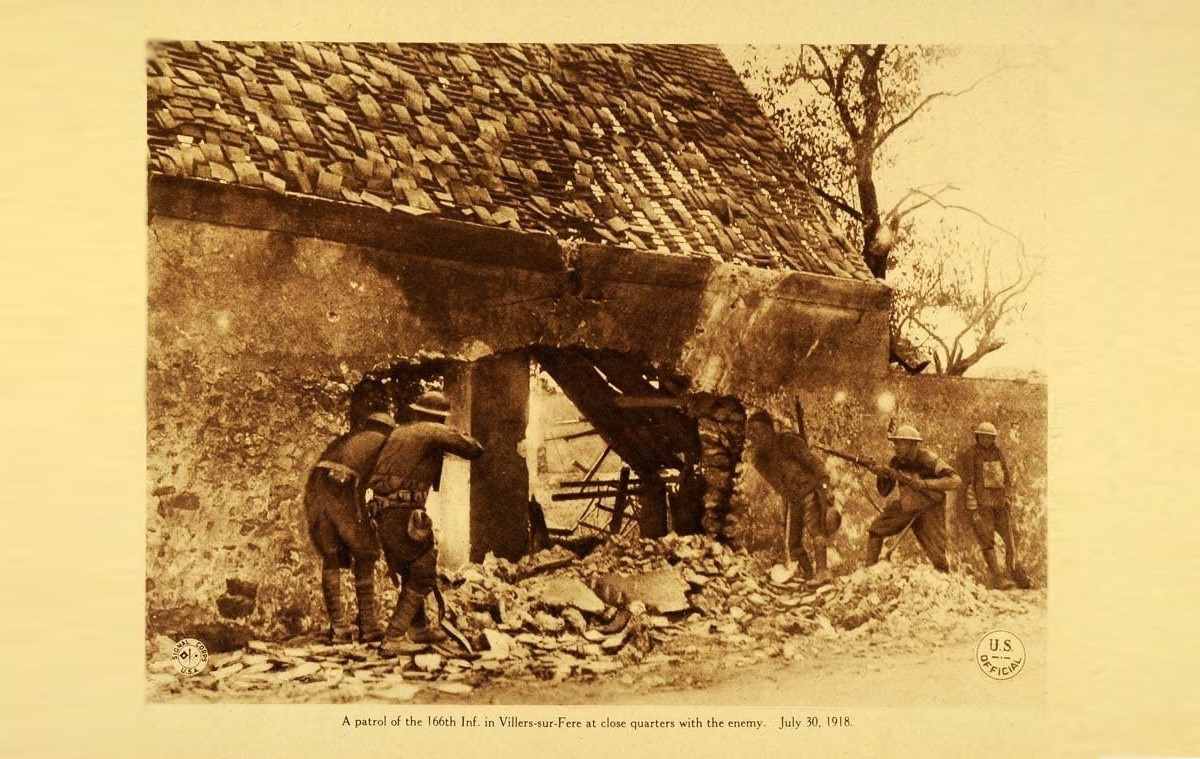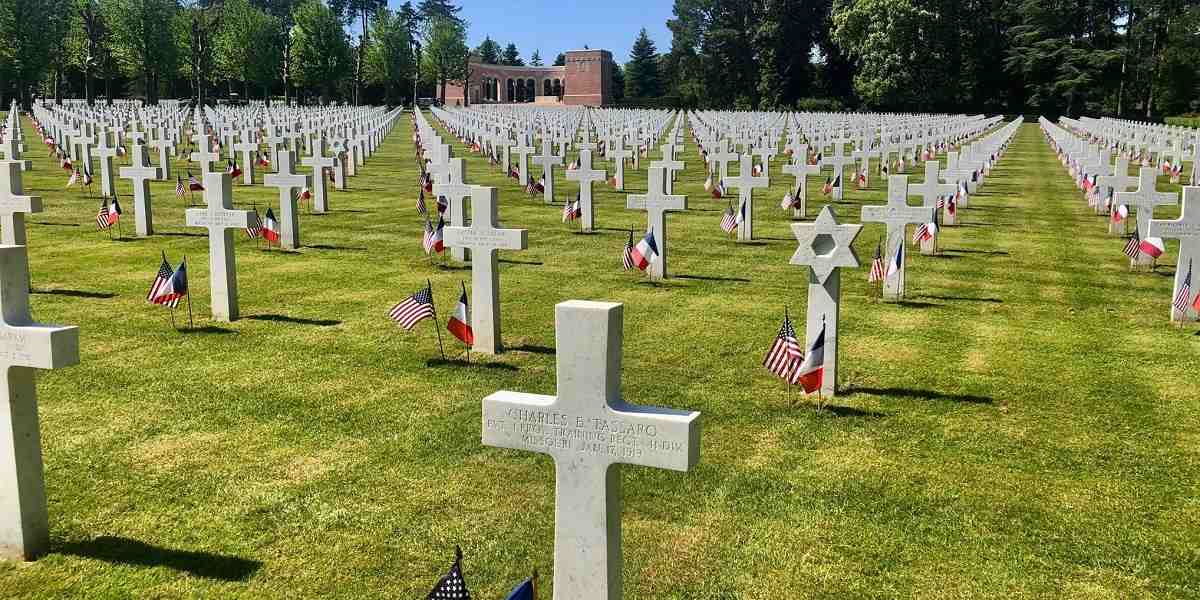
A photo shows a patrol of the 166th Infantry in close-quarters combat in Villers-sur-Fère, France, in 1918.
14:26 JST, May 28, 2023
On Feb. 8, 2022, a local undertaker, Jean-Paul Feval, was digging a grave in the cemetery at Villers-sur-Fère, a small village in the farm country of northeastern France.
The cemetery was beside a large field at the edge of town, on Rue Saint-Denis, just up the street from the old church of St. John the Baptist.

The grave holding the remains of the unknown World War I soldier is excavated in February 2022 in the cemetery in Villers-sur-Fère, France.
Feval had dug about four feet down when he began to unearth human bones, along with artifacts that would later include pieces of a helmet, a stretcher, a trench knife and a corroded, unreadable dog tag.
He had found the remains of an unknown American soldier, killed in July 1918 during fighting that had strewn the landscape around Villers-sur-Fère with hundreds of fallen “doughboys” during World War I.
Next month, more than a century later, the American Battle Monuments Commission plans to rebury the anonymous soldier in its nearby Oise-Aisne American Cemetery, about 70 miles northeast of Paris, where 6,000 of his comrades already rest.
It will be the first burial of an unknown American from World War I in 35 years, the commission said, and comes two years after the country marked the centennial of the Tomb of the Unknowns in Arlington National Cemetery in Virginia.
It also comes as the Arlington-based monuments commission celebrates its centennial this year.
The commission, which was started in 1923 to honor U.S. World War I dead overseas, operates 26 cemeteries on foreign soil where 123,000 service members from World Wars I and II are buried, and thousands of others are memorialized.
The soldier’s discovery “is an extraordinarily big deal,” said Mike Knapp, the commission’s director of historical services.
“Here we are . . . 105 years after this guy died and . . . he’s getting a full honors, military funeral just like some veteran would get today at Arlington” cemetery, Knapp said. “I think that says a great deal.”
“It’s a very important message for families of people who are still missing,” he said, and for current and future members of the services. “You are not forgotten.”
“I get choked up saying it,” he said. “But I think it’s really, really true.”
The soldier’s grave will be marked with a marble cross that reads: “Here Rests In Honored Glory An American Soldier Known But to God.”
The Army’s chief of staff, Gen. James C. McConville, is scheduled to speak at the June 7 funeral. The commission said the soldier will be buried with a Purple Heart medal.
The battle
In late July 1918, the U.S. Army’s 42d Infantry Division was pushing back German forces around the Ourcq River, less than a mile north of Villers-sur-Fère.
World War I – 1914-1918 – would end about three months later with the defeat of Germany and its allies by France, Britain, the United States, Russia and their allies.
But the closing weeks of the war saw some of the conflict’s most bitter fighting.
“It wasn’t people in trenches looking at each other,” Hubert Caloud, superintendent of the American Cemetery, said in a telephone interview. “As the Americans came up north, they had to fight for every little village . . . every little farmhouse . . . every piece of woods.”
“How did they do that?” he said. “They had to charge across open fields.”
The 42d was called the Rainbow Division because it contained outfits from across the country. Its chief of staff was future World War II hero Douglas MacArthur, the future general who reportedly gave the division its nickname.
One of its units was the 165th Infantry Regiment – previously called the “Fighting 69th” regiment – that included many Irish Americans from New York.
Francis Duffy was its chaplain. (A bronze statue of him stands in New York’s Times Square.)
The regiment lost 264 men in the Battle of the Ourcq River, according the New York State Military Museum and Veterans Research Center.
Among the dead was the poet Joyce Kilmer, author of the poem “Trees.” He was shot in the head by a sniper. “God rest his dear and gallant soul,” Father Duffy wrote after the war. Kilmer is buried in the Oise-Aisne American Cemetery.

American and French flags are planted near headstones Friday at the Oise-Aisne American Cemetery in northern France.
A soldier from Washington
The newly found soldier was identified as American because of the fragments of American equipment – bullets, uniform buttons, trench knife – that were with his remains, said Caloud, the cemetery superintendent.
“There was no doubt in our minds,” he said.
In 2006, the almost complete skeletal remains of a World War I American soldier, Pvt. Thomas D. Costello, were found by relic hunters in eastern France.
After experts were able to identify him, he was returned to the United States and buried in Arlington Cemetery in 2010.
In this case, the unknown’s remains consisted only of some vertebrae, ribs and other bones. “I was disappointed that we didn’t find more,” Caloud said.
“He was somebody’s son,” he said. “Maybe somebody’s father. Maybe somebody’s husband. We don’t know.”
How he was killed is a mystery.
“This is a combat death,” said Caloud, who served in the Marine Corps for 30 years. “He had an ammunition belt on. . . . It could have been a traumatic explosion, and that’s all that was left of the guy.”
Or part of his body was previously removed by accident, he said.
“This is an American soldier who was violently killed, and I wanted him buried,” Caloud said. “I didn’t want him to be a bunch of bones on an aluminum table that no one would ever pay attention to.”
The discovery of part of a stretcher in the grave is evocative.
“During the fighting they tried to get rid of the bodies as soon as they could,” Caloud said. “They would roll them up in ponchos. They’d roll them up in blankets. They could carry them on stretchers.”
“My guess is he was dead, and what was left of him was put on a stretcher,” he said.
The soldier was probably with the Rainbow Division because the village where he was found was in the area where the division fought, the commission said.
And he could well have been with the 165th, which saw intense action around Villers-sur-Fère. More than 30 Americans, including the unknown, were hastily buried by a stone wall that surrounded the village cemetery.
“We believe the people buried along that wall were from the 165th Regiment,” Caloud said, although other units were in the area and this man might have been from one of those too.
“The town of Villers-sur-Fère was throughout the action a part of the battlefield,” Father Duffy wrote in his postwar memoir, “Father Duffy’s Story.”
“Nearly one-third of those who lost their lives in this action received their death wounds from shell fire in and around Villers-sur-Fère,” he recounted.
One of those killed was Maj. William B. Hudson, a 40-year-old Washington physician, who was serving in the 165th.
Hudson was standing in the doorway of a building in the village when he was struck by a fragment from an enemy gas shell.
It “hit him full in the chest, killing him instantly,” Duffy wrote. “We buried him sadly by the cemetery wall where already too many of our men were lying in their last long sleep.”
Hudson was later exhumed and reburied in Arlington Cemetery. His name is carved on the D.C. War Memorial on the National Mall.
After the war, most of those buried by the wall were probably moved to larger cemeteries, or sent home, said Knapp, the commission historian. Except for this unknown.
“The question remains; ‘Was this guy overlooked entirely? Did they think they had him?'” Knapp said. “We’ll never know.”
After Feval discovered the remains, he called the police. The French national veterans office was also called in. A noted French World War I archaeologist, Yves Desfossés, was summoned. The grave was expanded, and more material was found.
On June 7, plans are for the unknown soldier to be buried in a silver casket, and borne to his grave amid the sounds of an artillery salute and Chopin’s funeral march.
"News Services" POPULAR ARTICLE
-

American Playwright Jeremy O. Harris Arrested in Japan on Alleged Drug Smuggling
-

Japan’s Nikkei Stock Average as JGB Yields, Yen Rise on Rate-Hike Bets
-

Japan’s Nikkei Stock Average Licks Wounds after Selloff Sparked by BOJ Hike Bets (UPDATE 1)
-

Japan’s Nikkei Stock Average Buoyed by Stable Yen; SoftBank’s Slide Caps Gains (UPDATE 1)
-

Japanese Bond Yields Zoom, Stocks Slide as Rate Hike Looms
JN ACCESS RANKING
-

Keidanren Chairman Yoshinobu Tsutsui Visits Kashiwazaki-Kariwa Nuclear Power Plant; Inspects New Emergency Safety System
-

Imports of Rare Earths from China Facing Delays, May Be Caused by Deterioration of Japan-China Relations
-

University of Tokyo Professor Discusses Japanese Economic Security in Interview Ahead of Forum
-

Japan Pulls out of Vietnam Nuclear Project, Complicating Hanoi’s Power Plans
-

Govt Aims to Expand NISA Program Lineup, Abolish Age Restriction



















